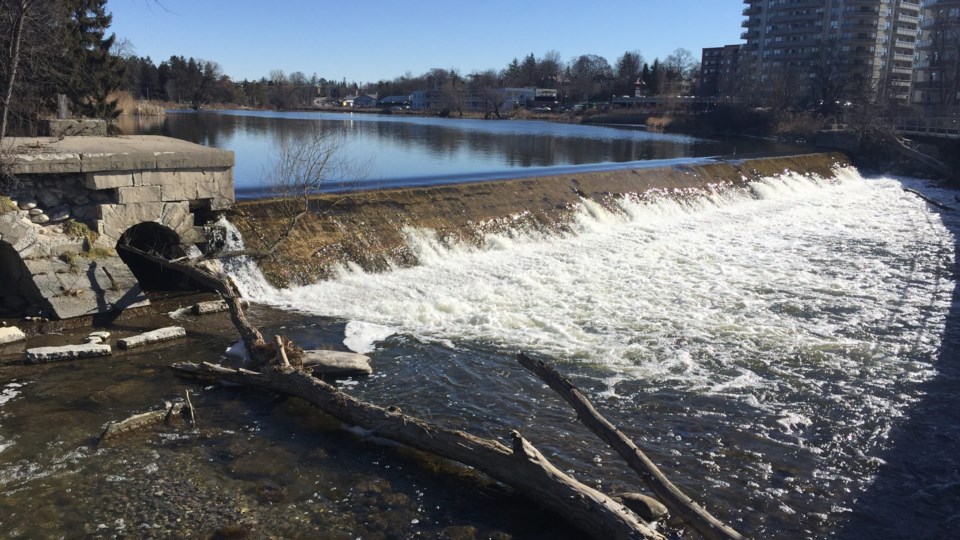Representatives from Six Nations of the Grand River want the decision to reconstruct the Riverside Dam in Cambridge to be reconsidered.
After years of debate on whether the project should go ahead, Cambridge city council voted to rebuild the Riverside Dam in June 2018.
The project is scheduled to begin in 2022.
“Our position is that the dam doesn’t need to be there. There is no need for it. This was communicated to the city years ago,” says Bethany Kuntz-Wakefield, wildlife and stewardship manager for the Elected Council of the Six Nations of the Grand River.
“When looking at the cultural heritage and evaluation report, the reason for replacing the dam is based on the cultural heritage value to the community. That report only mentions Six Nations of the Grand River in one sentence.”
The Riverside Dam is located on disputed lands, currently under litigation.
“Six Nations of the Grand River have never surrendered their rights to the Grand River. Since the beginning of time, the area was used for hunting and fishing. This river is important to them,” Kuntz-Wakefield said.
“There is no reason for the dam, except for heritage reasons. The river has been there for thousands of years. But this is the settler cultural heritage, not the Indigenous cultural heritage.”
Kuntz-Wakefield says that in terms of regulations, the Indigenous perspective is often missing.
“People talk about the boating uses of the river. The indigenous uses were never considered, only the settler uses,” Kuntz-Wakefield says.
“We want naturalization of the river, but this isn’t even being considered.”
In 2009, a structural evaluation of the dam was completed by Cambridge city staff. It was concluded that the dam was in need of repair.
The city’s evaluation of the alternatives determined that naturalizing the river was the preferred option.
In March 2018, in response to community feedback, city councillors asked staff to prepare another report on how to proceed with repairing or rebuilding the dam.
According to the cultural heritage report, Riverside Dam is over 130 years-old and is recognized as a cultural heritage structure.
“I have always been in favour of the project because it is a part of our heritage,” says Coun. Mike Mann. “It provides a sense of community and trying to maintain it is part of our heritage. It is important to preserve this.”
But, Mann says, that with a number of capital projects currently under way, costs of the Riverside Dam project have increased.
“Yes, I am in favour of the project, but we have to look at the best course of action to proceed," Mann said.
“It’s a difficult time. We want a place for people to come and enjoy but we also have to consider the cost involved and look at this very closely.”
The dam was budgeted in 2019 at $5.4 million, rising to $16.4 million for 2022.
Additional elements in the design and cost include operating gates and valves to reduce flooding potential and help pass sediment, a fish ladder or alternative fish passage method, health and safety apparatus for safe access, fencing, signs and river barriers.
“All of this has increased the cost,” says Coun. Pam Wolf.
In 2018, Wolf, who sits on the city’s environmental and heritage advisory committees, requested that council reconsider its decision.
Wolf says many people including the city’s environmental advisory committee, the Ministry of Natural Resource and Forests, and the Grand River Conservation Authority are opposed to reconstruction of the dam.
Wolf argues that the removal of the dam would not ruin the park but would make the river healthier.
“My opinion has not changed. I think council made the wrong decision, a decision not based on science, but based on people’s reluctance to change,” Wolf said.
“Naturalization was the preferred choice and it’s been seven years of consultation. There are many groups opposed, including Six Nations of the Grand River.”
Kuntz-Wakefield says that holistically, the dam is not functioning properly.
“There are nearly two dozen fish species at risk. We need something that will preserve our fish, prevent flooding and does not interrupt the natural process,” she said.
“There would also be significant opportunities for riparian rehabilitation which includes the vegetation beside the river.”
Wolf says there are so many other things that could have been done such as adding more trails or a dock.
“And with naturalization, the costs of maintenance with the dam would no longer be,” Wolf said.
Wolf says people are often resistant to change.
“But without change, we will not flourish,” she said.
Kuntz-Wakefield says that hard infrastructure interrupts the natural process.
“This is what we value. It is important to know that Indigenous values are not always consistent with settler values,” she said.
“And these are the values that Indigenous people want to protect.”



